Your Call?
Which of today’s four featured images is your favorite? Leave a comment and let us know why you made your choice and you will likely learn something!
What’s Up?
Happy holidays to all.
We spent the last morning of the first San Diego IPT at Santee Lakes. Though it was not the greatest day ever, we had many good chances with Wood and Ring-necked Ducks. And we ended the morning with decent images of a Lewis’s Woodpecker, a rare visitor to San Diego. I took the afternoon off despite the nice weather.
Each of the three pelican mornings has been among the best I have enjoyed in three decades of photographing in San Diego. Remembering that you only live once, you just might want to call Jim at the office at 863-692-0906, leave a deposit for the second or third San Diego, or e-mail me and ask about doing a few In-the-Field Days in January, and then get yourself a flight to San Diego.
Please shoot me an e-mail if you would like to receive the San Diego IPT #2 Late Registration Discount info.
Today is Sunday 25 December 2022. For those who celebrate the holiday, I hope that Santa brought you what you wanted. With clear skies and a NE breeze skies forecast for today, I will surely head to the pelican cliffs. This blog post took two hours to prepare and makes two hundred seventy-two days in a row with a new, educational post just for you. Wherever you are and whatever you are doing, I hope that you too have a great day.
Please remember to use the B&H and Amazon links that are found on most blog pages and to use the BIRDSASART discount code at checkout when purchasing your new gear from Bedfords to get 3% back on your credit card and enjoy free second-day air FedEx. Please, also, consider joining a BAA IPT. You will be amazed at how much you will learn!
You can find some great photo accessories (and necessities, like surf booties!) on Amazon by clicking on the Stuff tab on the orange/yellow menu bar above. On a related note, it would be extremely helpful if blog-folks who, like me, spend too much money on Amazon, would get in the habit of clicking on the Amazon logo link on the right side of each blog post when they shop online. As you might expect, doing so will not cost you a single penny, but would be appreciated tremendously by yours truly. And doing so, works seamlessly with your Amazon Prime account.
Please remember that if an item — a Delkin flash card, or a tripod head — for example, that is available from B&H and/or Bedfords, is also available in the BAA Online Store, it would be great, and greatly appreciated, if you would opt to purchase from us. We will match any price. Please remember also to use my B&H affiliate links or to earn 3% cash back at Bedfords by using the BIRDSASART discount code at checkout for your major gear purchases. Doing either often earns you free guides and/or discounts. And always earns my great appreciation.
|
|
|
This image was created on 23 December on the third morning of the first San Diego IPT. I used the handheld Sony FE 200-600mm f/5.6-6.3 G OSS lens (at 200mm) and The One, the Sony Alpha 1 Mirrorless digital camera. ) Working in Shutter Priority + two-stops with Exposure Compensation on the Thumb Dial, Zebra technology was used to determine the correct exposure. AUTO ISO set ISO 2500! 1/20 second at f/5.6 (wide open). AWB at 6:42:34am about an hour before the sun would crest the hill to the east. RawDigger showed the exposure to be dead-solid-perfect. Expand Flexible Spot AF-C with Bird Face-eye Detection enabled performed perfectly. Be sure to click on the image to enjoy a high-res version. Image #1: Brown Pelican juveniles — pre-dawn landing blur
|
Necessity, the Mother of Invention
If you insist on making only sharp images in extreme low light conditions, you will be working with unheard of high ISOs. Note that at 1/20 second I needed ISO 2500 to get the right exposure. What would the ISO have been had I been working even at a conservative 1/1600 second for flying birds? I am not gonna take the time to figure it out but even if your camera goes that high, the results would be horrific at best.
My choice is to go with the flow and strive to some create pleasing blurs. Remember that the shower the shutter speed you choose, the lower your percentage of keepers will but that your chance of winning a prestigious contest will be.
|
|
|
This image was also created on 23 December on the third morning of the first San Diego IPT. I used the handheld Sony FE 200-600mm f/5.6-6.3 G OSS lens (at 200mm) and The One, the Sony Alpha 1 Mirrorless digital camera. ) Working in Shutter Priority + 1.7-stops with Exposure Compensation on the Thumb Dial, Zebra technology was used to determine the correct exposure. AUTO ISO set ISO 2000! 1/250 second at f/6.3 (wide open). AWB at 7:27:47am in dense fog. RawDigger showed the exposure to be dead-solid-perfect. Expand Flexible Spot AF-C with Bird Face-eye Detection enabled performed perfectly. Be sure to click on the image to enjoy a high-res version. Image #2: Brown Pelicans — Pacific race adults on cliff
|
Working in Shutter Priority!
As regular readers know, I sometimes opt to work in Shutter Priority Mode in low light. That is easiest to do with Sony because of Zebras. It was easy to got from a very low blur shutter speed to the fast enough shutter speed of 1/250. sec. The trick is that you have to know your way around getting the right exposure with whatever gear you are using.
Fog Processing
Because of the fog, the properly exposed raw file for Image #2 was totally flat and lacking contrast and color. I will walking about processing such images in a blog post here soon.
|
|
|
This image was also created on 23 December on the third morning of the first San Diego IPT. I used the hand held Sony FE 70-200mm f/2.8 GM OSS II lens (at 102mm) and The One, the Sony Alpha 1 Mirrorless Digital Camera.. The exposure was determined via Zebras with ISO on the thumb dial. ISO 640: 1/1250sec. at f/2.8 (wide open) in Manual mode. AWB at 8:39:48am on after the fog returned. Tracking: Spot S AF/C with Bird-Eye/Face Detection performed perfectly. Click on the image to enjoy a high-res version. Image #3: Brown Pelicans and photographers on the lower shelf |
Taking a Walk
While Anar stayed on the cliffs, I took a walk up the steps and down the hill with the handheld 400 f/2.8 and the 70-200 on a Black Rapid Curve Breathe Strap on my shoulder. I used the latter to create Image #3. Here’s a good tip for creating bird scape and scenic images with a zoom lens: always zoom a bit wider so that you have room to crop if need be. With this image, I cropped from above and the right to eliminate a pelican on the right frame-edge
2022/2023 Juvenile Brown Pelicans
The last breeding season was surely a banner one as there are a zillion young of the year birds this year. Some years, you have to search to find two or three juvie. You can tell them from the adults by their brown upper parts and their white bellies. The adults are silver/grey above with speckled charcoal or nearly black bellies.
|
|
|
This image was also created on 23 December on the third morning of the first San Diego IPT. While standing, I used the handheld Sony FE 400mm f/2.8 GM OSS lens and The One, the Sony Alpha 1 Mirrorless Digital Camera. The exposure was determined via Zebra technology with ISO on the Thumb Dial. ISO 1250. 1/1600 sec. at f/3.5 (stopped down 2/3-stop in error) in Manual mode. When evaluated in RawDigger, the raw file exposure was determined to be perfect. AWB at 9:15:33am on a then foggy morning. Tracking: Flexible Spot S AF-C with Bird Face/Eye detection enabled performed to perfection. Be sure to click on the image to enjoy a high-res version. Image #4: Brown Pelican juvenile landing in light fog |
The 400mm f/2.8
The lens that I advised against for nearly forty years has become one of my favorites and has been incredibly valuable in San Diego. It is superb for low light flight at La Jolla, especially if you know where to be.
San Diego IPT ##2 Late Registration Discount Info and In-the-Field Instructional Photo Sessions
Please shoot me an e-mail if you would like to receive the San Diego IPT #2 Late Registration Discount info. Note that due to one cancellation and one switch, there are now two opening on San Diego #2. As I will be in San Diego for five weeks, I have lots of free days for In-the-Field Instructional Sessions, again, e-mail for rates and details.
|
|
|
This all-new card includes images created on my JAN 2022 visit to San Diego. Click on the composite to enjoy a larger version. |
The 2022/23 San Diego Brown Pelicans (and more!) IPTs
San Diego IPT #1. 3 1/2 DAYS: WED 21 DEC thru the morning session on Saturday 24 DEC 2022. $2099.00. Deposit: $699.00. Limit: 6 photographers/Openings: 5.
San Diego IPT #2. 4 1/2 DAYS: SAT 7 JAN thru the morning session on WED 11 JAN 2023: $2699.00. Deposit: $699.00. Limit: 6 photographers/Openings: 2.
San Diego IPT #3: 4 1/2 DAYS: THURS 19 JAN thru the morning session on MON 23 JAN 2023: $2699.00. Deposit: $699.00. Limit: 6 photographers/Openings: 5.
Please e-mail for information on personalized pre- and post-IPT and In-the-Field Sessions.
Join me in San Diego to photograph the spectacular breeding plumage Brown Pelicans with their fire-engine red and olive green bill pouches; Brandt’s (nesting) and Double-crested Cormorants; breeding plumage Wood and Ring-necked Ducks; other duck species possible including Lesser Scaup, Redhead, Northern Shoveler and Surf Scoter; a variety of gulls including Western, California, and the gorgeous Heermann’s, all in full breeding plumage; shorebirds including Marbled Godwit, Willet, Sanderling and Black-bellied Plover; many others are possible including Least, Western, and Spotted Sandpiper, Whimbrel, Black and Ruddy Turnstone, Semipalmated Plover, and Surfbird; Harbor Seals and California Sea Lions (both depending on the current regulations and restrictions). And as you can see by studying the IPT cards, there are some nice bird-scape and landscape opportunities as well. Not to mention a ton of excellent flight photography opportunities and instruction.
Please note: where permitted and on occasion, ducks and gulls may be attracted (or re-located) with offerings of grains or healthy bread.
|
|
|
San Diego offers a wealth of very attractive natural history subjects, including and especially the Pacific race of California Brown Pelican. With annual visits spanning more than four decades, I have lots of photographic experience there … Click on the composite to enjoy a larger version. |
Learning Exposure, Whether You Like It Or Not
Whether you like it or not, we will be beating the subject of exposure like a dead horse. In every new situation, you will hear my thoughts on exposure along with my thoughts on both Nikon and Canon histograms and SONY Zebras. Whether you like it or not, you will learn to work in manual mode so that you can get the right exposure every time (as long as a bird gives you ten seconds with the light constant). Or two seconds with SONY zebras … And you will learn what to do when the light is changing constantly. What you learn about exposure will be one of the great takeaways on every IPT.
|
|
|
Though the pelicans will be the stars of the show on this IPT, there will be many other handsome and captivating subjects in wonderful settings. Click on the composite to enjoy a larger version. |
It Ain’t Just Pelicans
With gorgeous subjects just sitting there waiting to have their pictures taken, photographing the pelicans on the cliffs is about as easy as nature photography gets. With the winds from the east almost every morning there is usually some excellent flight photography as well, often with 70-200mm lenses! And the pelicans are almost always doing something interesting: preening, scratching, bill pouch cleaning, or squabbling. And then there are those crazy head throws that are thought to be a form of intra-flock communication. You will be guided as to how to make the best of those opportunities. Depending on the weather, the local conditions, and the tides, there are a variety of other fabulous photo chances available in and around San Diego.
|
Did I mention that there are lots of great birds and natural history subjects in San Diego in winter? Click on the composite to enjoy a larger version. |
The San Diego Details
These IPTs will include four or five 3-hour morning photo sessions, three or four 1 1/2-hour afternoon photo sessions, and three or four working brunches that will include image review and Photoshop sessions. On rare cloudy days, we may — at the leader’s discretion, stay out in the morning for a long session and skip that afternoon. To ensure early starts, breakfasts will be your responsibility. And so that we can get some sleep, dinners will be on your own as well. In the extremely unlikely event that Goldfish Point is closed due to local ordinance (or whimsy) — that has never happened in the past fifty years, I will of course do my very best to maximize our photographic opportunities.
|
|
|
San Diego offers a wealth of very attractive natural history subjects, including and especially the Pacific race of California Brown Pelican. With annual visits spanning more than four decades, I have lots of photographic experience there … Click on the composite to enjoy a larger version. |
Deposit Info
A $699 deposit is required to hold your slot for one of the 2022/23 San Diego IPTs. You can send a check (made out to “BIRDS AS ART”) to us here: BIRDS AS ART, PO Box 7245, Indian Lake Estates, FL, 33855, or call Jim or Jennifer at the office with a credit card at 863-692-0906. Your balance, payable only by check, is due three months before the trip.
|
Variety is surely the spice of life in San Diego. Click on the composite to enjoy a larger version. |
Getting Up Early and Staying Out Late
On all BIRDS AS ART IPTS including and especially the San Diego IPT, we get into the field early to take advantage of unique and often spectacular lighting conditions and we stay out late to maximize the chances of killer light and glorious sunset silhouette situations. We often arrive at the cliffs a full hour before anyone else shows up to check out the landscape and seascape opportunities.
Typos
With all blog posts, feel free to e-mail or to leave a comment regarding any typos or errors.

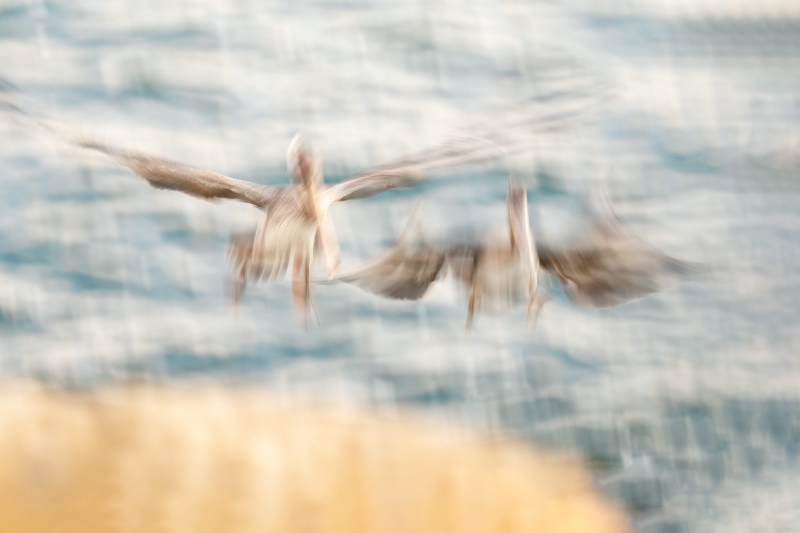
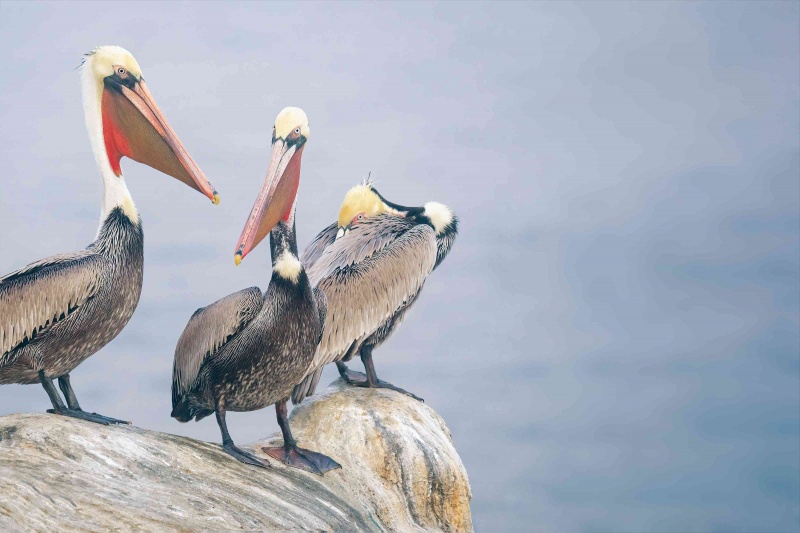
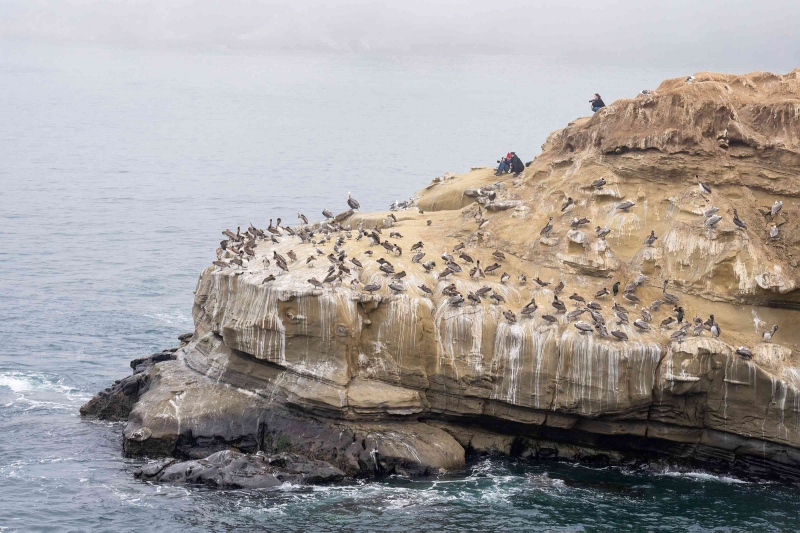
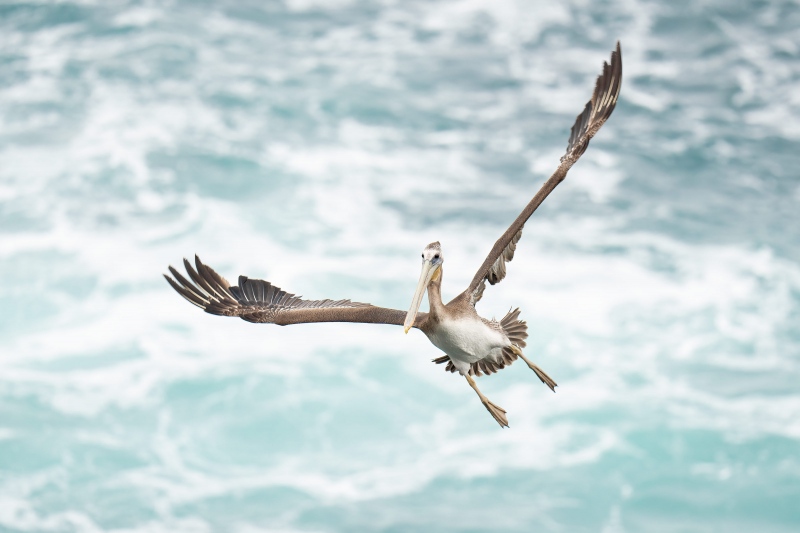
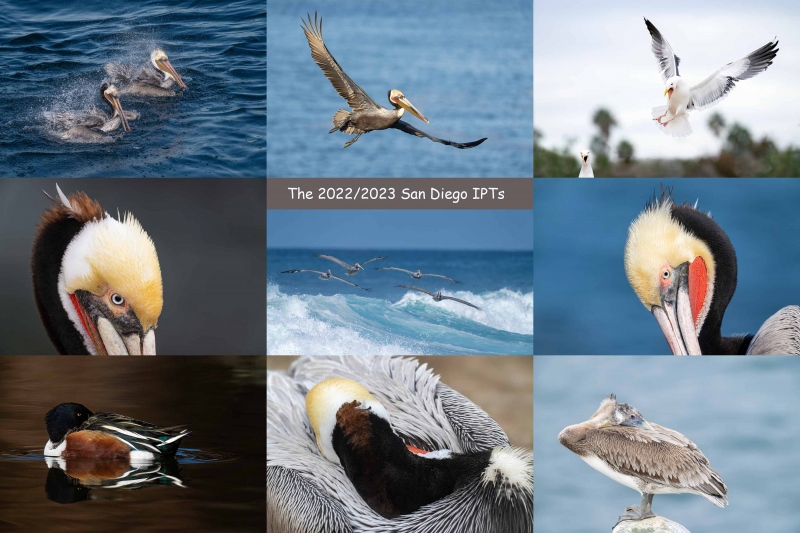
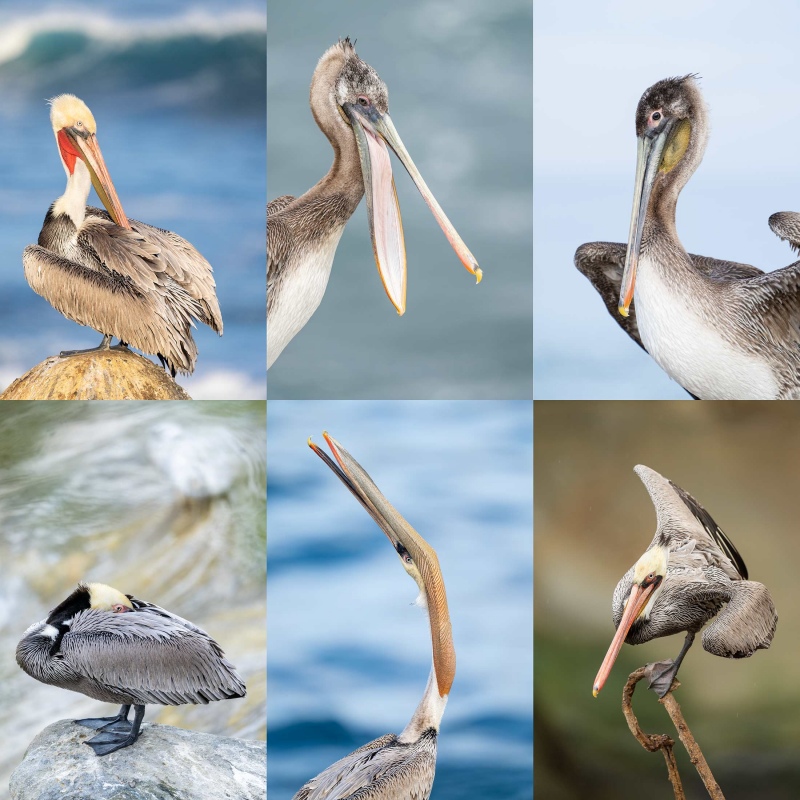
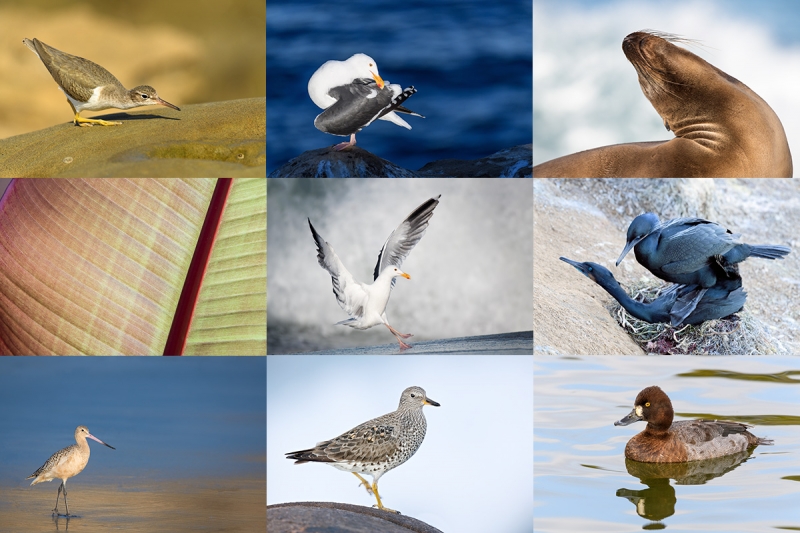

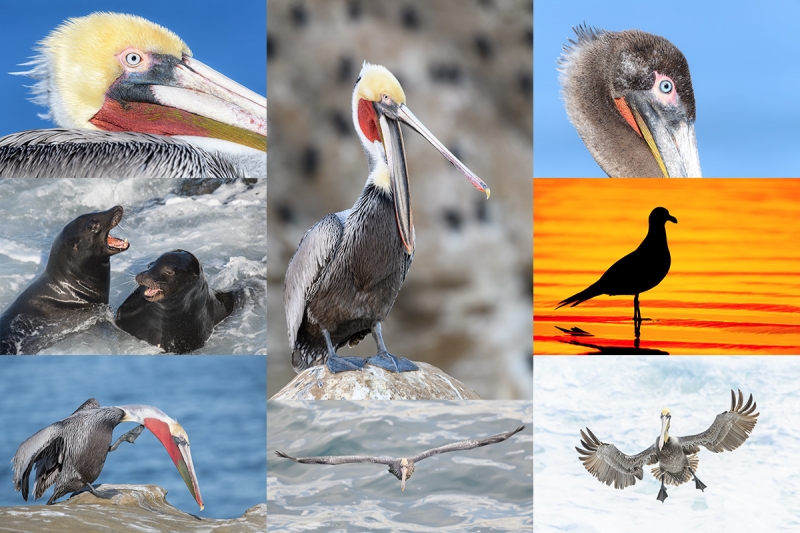














Hi Artie,
Wishing you an early Happy New Year.
Wow. Image #3 really highlights how close you can get to the pelicans.
Small typo:
– We spent the lasts morning of the first San Diego IPT – s/b last
Thanks and fixed on the typo. On Monday morning there were a zillion pelicans up top. At 9:00am, you could easily walk up with ten feet of big groups of them. If you sat and moved slowly, you could like have gotten within a yard of one.
artie
Oh Image 1 is well made though Sue…. It’s appearance is creatively deliberate and you either like or hate these ‘artistic’ blurs. Personally, non keen at all and I suspect you’re not either!
My preference is for Image 2, such a well captured, interesting little group of these wonderful birds.
Image #2 Brown Pelicans is very interesting and well made!! Image #4 Brown Pelican is well made and cute!! Image #3 Brown Pelicans and photographers is WOW!! Image #1 Brown Pelican juveniles is not well made and hard to see the two Brown Pelicans.
Hi Artis, regarding your iso question , you would have to be 1/3 of a stop north of iso 160,000 so I’m not sure what that number is but maybe iso 240,000 or there abouts. Is there even a camera anywhere that could do such a thing.?
One of Nikon’s cameras goes up to 5 million if I remember right.
I lied. It’s only 3,280,000. . Nikon D5.